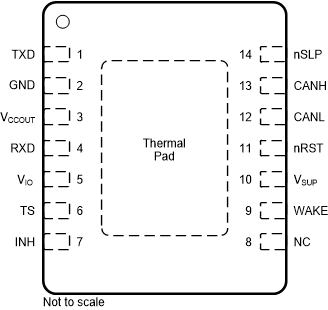ZHCSPC3A May 2021 – November 2021 TCAN11623-Q1 , TCAN11625-Q1
PRODUCTION DATA
- 1 特性
- 2 应用
- 3 说明
- 4 Revision History
- 5 说明(续)
- 6 Pin Configurations and Functions (TCAN11625)
- 7 Pin Configurations and Functions (TCAN11623)
- 8 Specifications
- 9 Parameter Measurement Information
-
10Detailed Description
- 10.1 Overview
- 10.2 Functional Block Diagram
- 10.3 Feature Description
- 10.4 Device Functional Modes
- 11Application Information
- 12Power Supply Requirements
- 13Layout
- 14Device and Documentation Support
- 15Mechanical, Packaging, and Orderable Information
6 Pin Configurations and Functions (TCAN11625)
 Figure 6-1 DMT Package, 14 Pin (VSON),
Top View
Figure 6-1 DMT Package, 14 Pin (VSON),
Top ViewTable 6-1 Pin Functions
| PINS | TYPE | DESCRIPTION | |
|---|---|---|---|
| NAME | NO. | ||
| TXD | 1 | Digital | CAN transmit data input, integrated pull-up |
| GND | 2 | GND | Ground connection |
| VCCOUT | 3 | Supply | 5-V LDO regulated output voltage pin and transceiver supply |
| RXD | 4 | Digital | CAN receive data output, tri-state when VIO < UVVIO |
| VIO | 5 | Supply | IO supply voltage |
| TS | 6 | Digital | Transceiver status |
| INH | 7 | High Voltage | Inhibit pin to control system voltage regulators and supplies, high voltage |
| NC | 8 | — | Internally connected, leave floating or connect to GND |
| WAKE | 9 | High Voltage | Local WAKE input terminal, high voltage |
| VSUP | 10 | Supply | High voltage supply from the battery |
| nRST | 11 | Digital | Reset input/output |
| CANL | 12 | Bus IO | Low level CAN bus input/output line |
| CANH | 13 | Bus IO | High level CAN bus input/output line |
| nSLP | 14 | Digital | Sleep mode control input, integrated pull-down |
| Thermal Pad | — | Electrically connected to GND, connect the thermal pad to the printed circuit board (PCB) ground plane for thermal relief | |